Business Management Report: Project Management of TESCO Expansion
VerifiedAdded on 2021/02/21
|6
|1565
|24
Report
AI Summary
This report provides a comprehensive analysis of the TESCO expansion project, focusing on the application of project management principles. It outlines the key stages of the project life cycle, including initiation, project definition, feasibility study, execution, and conclusion, as applied to TESCO's international expansion. The report details the usage and execution of project management tools such as Gantt charts and work breakdown structures, demonstrating how these tools are employed to manage schedules and simplify project execution. Furthermore, it identifies and categorizes project stakeholders, differentiating between internal and external stakeholders and their roles in the project's success. The report concludes by emphasizing the importance of project management in achieving business growth and success, highlighting the roles of project managers and stakeholders, and the significance of the project life cycle. References to relevant books and journals support the analysis.
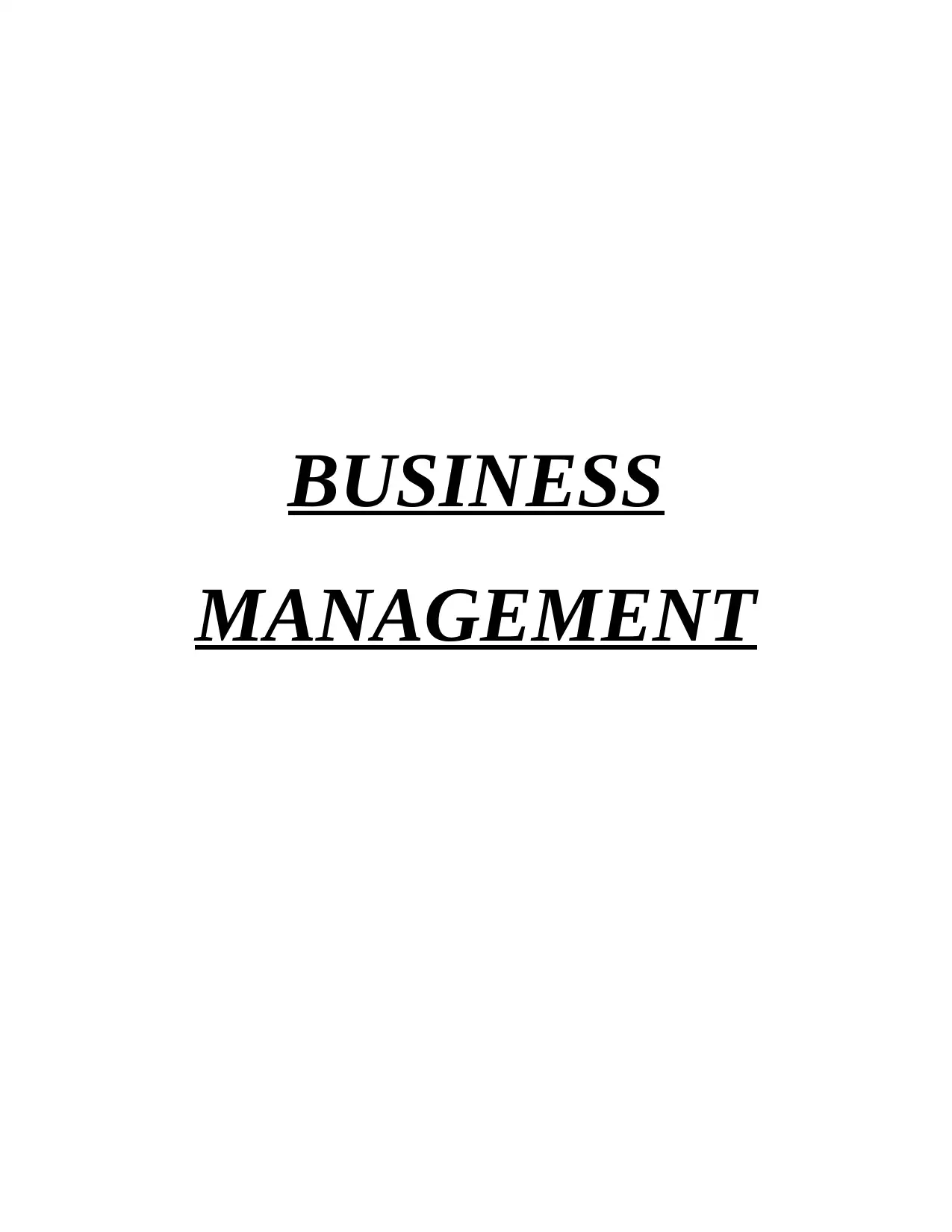
BUSINESS
MANAGEMENT
MANAGEMENT
Paraphrase This Document
Need a fresh take? Get an instant paraphrase of this document with our AI Paraphraser
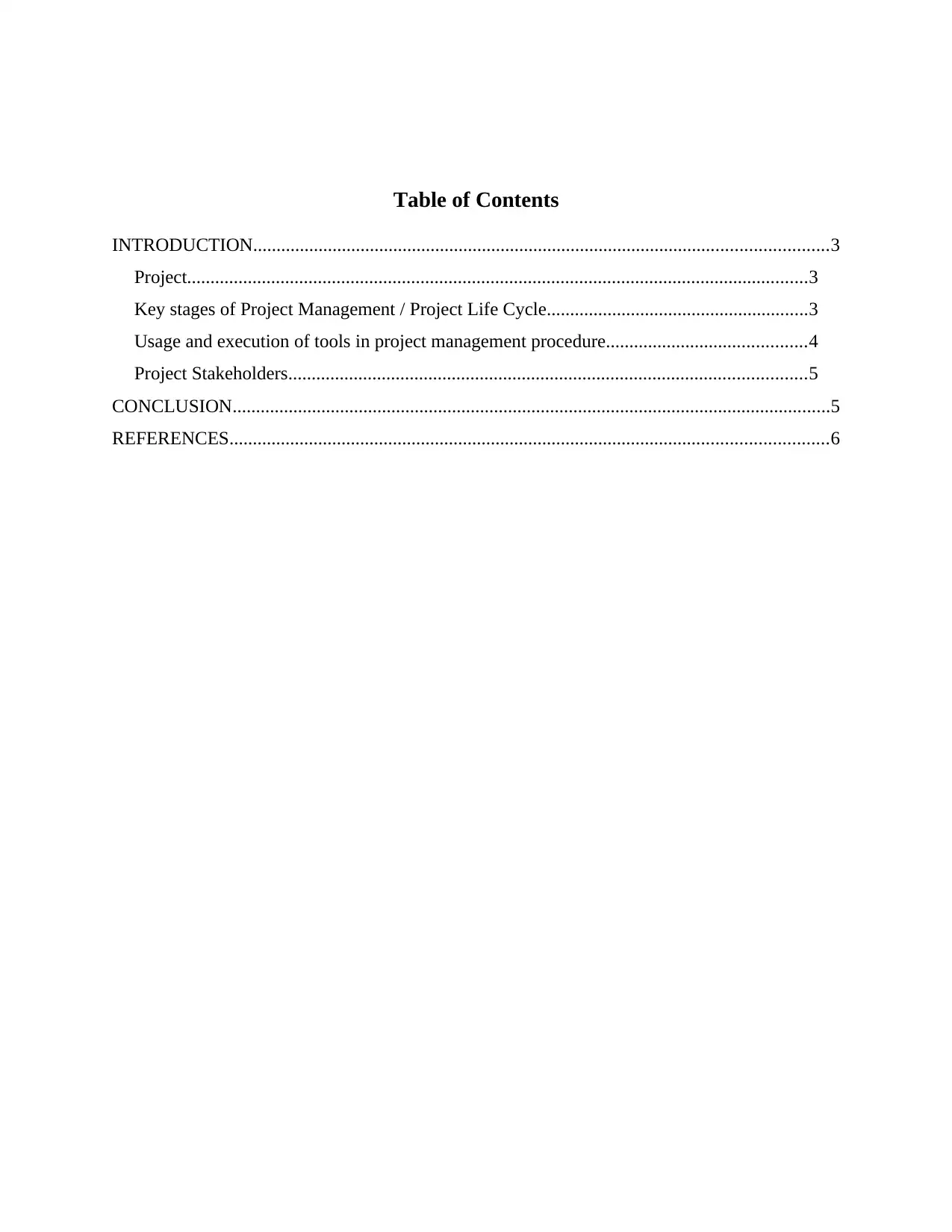
Table of Contents
INTRODUCTION...........................................................................................................................3
Project.....................................................................................................................................3
Key stages of Project Management / Project Life Cycle........................................................3
Usage and execution of tools in project management procedure...........................................4
Project Stakeholders...............................................................................................................5
CONCLUSION................................................................................................................................5
REFERENCES................................................................................................................................6
INTRODUCTION...........................................................................................................................3
Project.....................................................................................................................................3
Key stages of Project Management / Project Life Cycle........................................................3
Usage and execution of tools in project management procedure...........................................4
Project Stakeholders...............................................................................................................5
CONCLUSION................................................................................................................................5
REFERENCES................................................................................................................................6
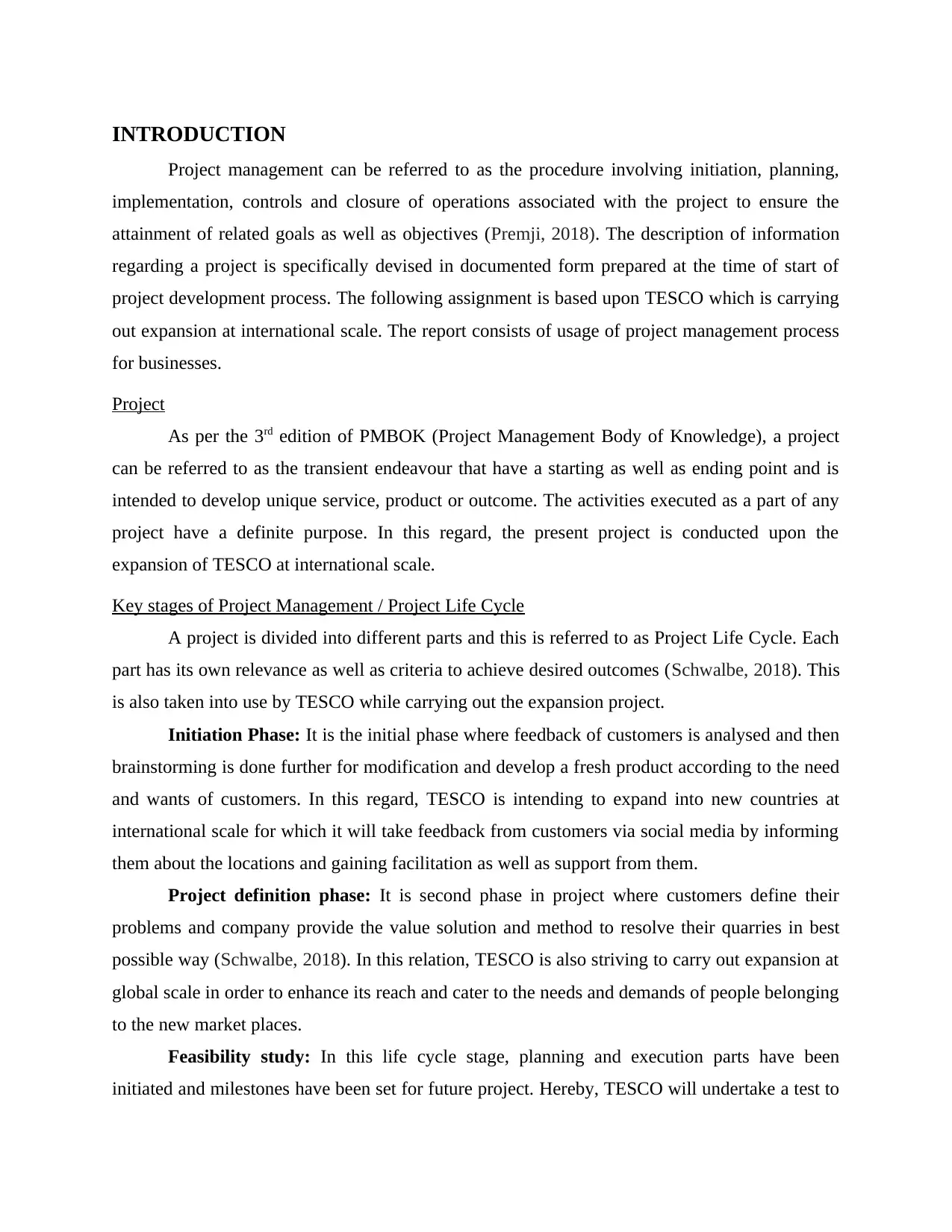
INTRODUCTION
Project management can be referred to as the procedure involving initiation, planning,
implementation, controls and closure of operations associated with the project to ensure the
attainment of related goals as well as objectives (Premji, 2018). The description of information
regarding a project is specifically devised in documented form prepared at the time of start of
project development process. The following assignment is based upon TESCO which is carrying
out expansion at international scale. The report consists of usage of project management process
for businesses.
Project
As per the 3rd edition of PMBOK (Project Management Body of Knowledge), a project
can be referred to as the transient endeavour that have a starting as well as ending point and is
intended to develop unique service, product or outcome. The activities executed as a part of any
project have a definite purpose. In this regard, the present project is conducted upon the
expansion of TESCO at international scale.
Key stages of Project Management / Project Life Cycle
A project is divided into different parts and this is referred to as Project Life Cycle. Each
part has its own relevance as well as criteria to achieve desired outcomes (Schwalbe, 2018). This
is also taken into use by TESCO while carrying out the expansion project.
Initiation Phase: It is the initial phase where feedback of customers is analysed and then
brainstorming is done further for modification and develop a fresh product according to the need
and wants of customers. In this regard, TESCO is intending to expand into new countries at
international scale for which it will take feedback from customers via social media by informing
them about the locations and gaining facilitation as well as support from them.
Project definition phase: It is second phase in project where customers define their
problems and company provide the value solution and method to resolve their quarries in best
possible way (Schwalbe, 2018). In this relation, TESCO is also striving to carry out expansion at
global scale in order to enhance its reach and cater to the needs and demands of people belonging
to the new market places.
Feasibility study: In this life cycle stage, planning and execution parts have been
initiated and milestones have been set for future project. Hereby, TESCO will undertake a test to
Project management can be referred to as the procedure involving initiation, planning,
implementation, controls and closure of operations associated with the project to ensure the
attainment of related goals as well as objectives (Premji, 2018). The description of information
regarding a project is specifically devised in documented form prepared at the time of start of
project development process. The following assignment is based upon TESCO which is carrying
out expansion at international scale. The report consists of usage of project management process
for businesses.
Project
As per the 3rd edition of PMBOK (Project Management Body of Knowledge), a project
can be referred to as the transient endeavour that have a starting as well as ending point and is
intended to develop unique service, product or outcome. The activities executed as a part of any
project have a definite purpose. In this regard, the present project is conducted upon the
expansion of TESCO at international scale.
Key stages of Project Management / Project Life Cycle
A project is divided into different parts and this is referred to as Project Life Cycle. Each
part has its own relevance as well as criteria to achieve desired outcomes (Schwalbe, 2018). This
is also taken into use by TESCO while carrying out the expansion project.
Initiation Phase: It is the initial phase where feedback of customers is analysed and then
brainstorming is done further for modification and develop a fresh product according to the need
and wants of customers. In this regard, TESCO is intending to expand into new countries at
international scale for which it will take feedback from customers via social media by informing
them about the locations and gaining facilitation as well as support from them.
Project definition phase: It is second phase in project where customers define their
problems and company provide the value solution and method to resolve their quarries in best
possible way (Schwalbe, 2018). In this relation, TESCO is also striving to carry out expansion at
global scale in order to enhance its reach and cater to the needs and demands of people belonging
to the new market places.
Feasibility study: In this life cycle stage, planning and execution parts have been
initiated and milestones have been set for future project. Hereby, TESCO will undertake a test to
⊘ This is a preview!⊘
Do you want full access?
Subscribe today to unlock all pages.

Trusted by 1+ million students worldwide
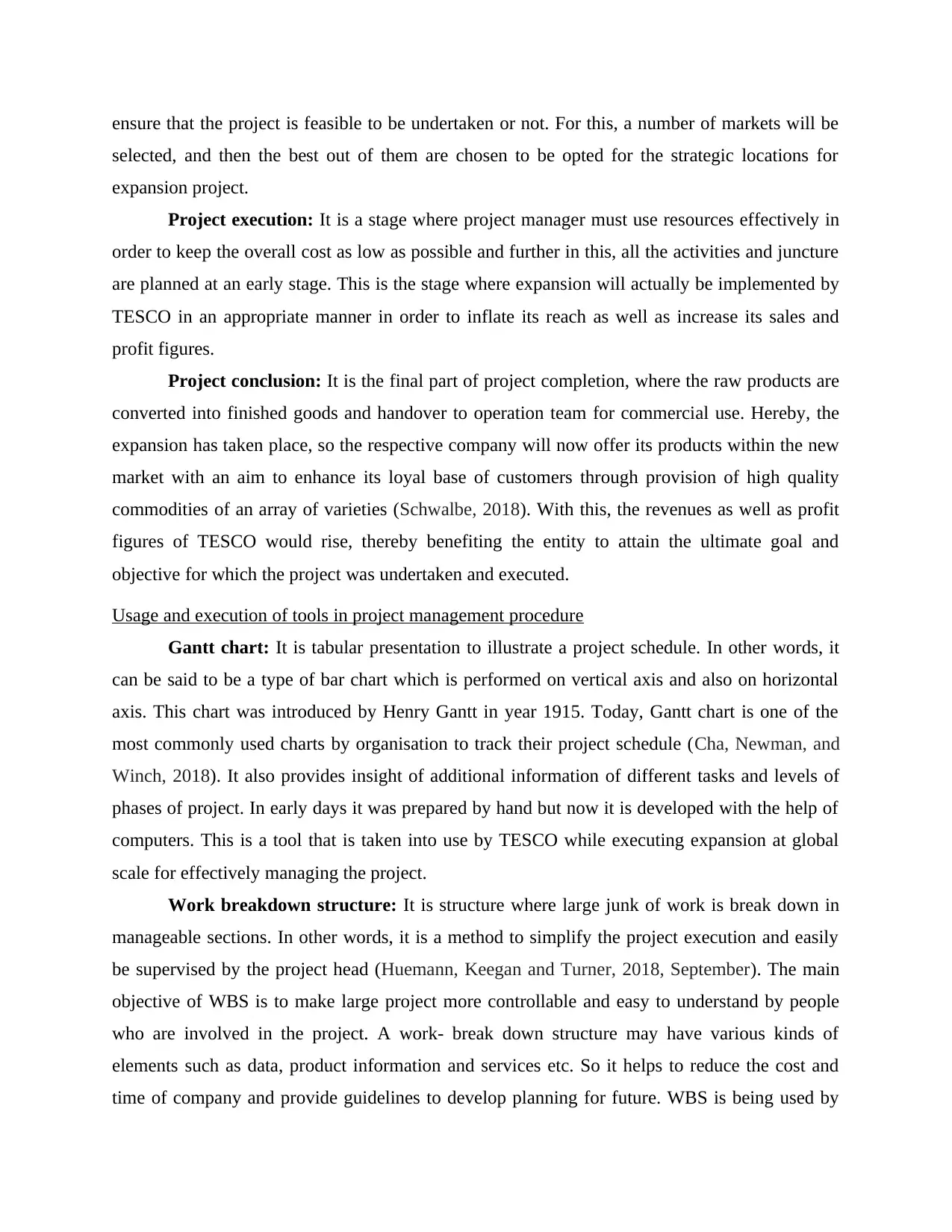
ensure that the project is feasible to be undertaken or not. For this, a number of markets will be
selected, and then the best out of them are chosen to be opted for the strategic locations for
expansion project.
Project execution: It is a stage where project manager must use resources effectively in
order to keep the overall cost as low as possible and further in this, all the activities and juncture
are planned at an early stage. This is the stage where expansion will actually be implemented by
TESCO in an appropriate manner in order to inflate its reach as well as increase its sales and
profit figures.
Project conclusion: It is the final part of project completion, where the raw products are
converted into finished goods and handover to operation team for commercial use. Hereby, the
expansion has taken place, so the respective company will now offer its products within the new
market with an aim to enhance its loyal base of customers through provision of high quality
commodities of an array of varieties (Schwalbe, 2018). With this, the revenues as well as profit
figures of TESCO would rise, thereby benefiting the entity to attain the ultimate goal and
objective for which the project was undertaken and executed.
Usage and execution of tools in project management procedure
Gantt chart: It is tabular presentation to illustrate a project schedule. In other words, it
can be said to be a type of bar chart which is performed on vertical axis and also on horizontal
axis. This chart was introduced by Henry Gantt in year 1915. Today, Gantt chart is one of the
most commonly used charts by organisation to track their project schedule (Cha, Newman, and
Winch, 2018). It also provides insight of additional information of different tasks and levels of
phases of project. In early days it was prepared by hand but now it is developed with the help of
computers. This is a tool that is taken into use by TESCO while executing expansion at global
scale for effectively managing the project.
Work breakdown structure: It is structure where large junk of work is break down in
manageable sections. In other words, it is a method to simplify the project execution and easily
be supervised by the project head (Huemann, Keegan and Turner, 2018, September). The main
objective of WBS is to make large project more controllable and easy to understand by people
who are involved in the project. A work- break down structure may have various kinds of
elements such as data, product information and services etc. So it helps to reduce the cost and
time of company and provide guidelines to develop planning for future. WBS is being used by
selected, and then the best out of them are chosen to be opted for the strategic locations for
expansion project.
Project execution: It is a stage where project manager must use resources effectively in
order to keep the overall cost as low as possible and further in this, all the activities and juncture
are planned at an early stage. This is the stage where expansion will actually be implemented by
TESCO in an appropriate manner in order to inflate its reach as well as increase its sales and
profit figures.
Project conclusion: It is the final part of project completion, where the raw products are
converted into finished goods and handover to operation team for commercial use. Hereby, the
expansion has taken place, so the respective company will now offer its products within the new
market with an aim to enhance its loyal base of customers through provision of high quality
commodities of an array of varieties (Schwalbe, 2018). With this, the revenues as well as profit
figures of TESCO would rise, thereby benefiting the entity to attain the ultimate goal and
objective for which the project was undertaken and executed.
Usage and execution of tools in project management procedure
Gantt chart: It is tabular presentation to illustrate a project schedule. In other words, it
can be said to be a type of bar chart which is performed on vertical axis and also on horizontal
axis. This chart was introduced by Henry Gantt in year 1915. Today, Gantt chart is one of the
most commonly used charts by organisation to track their project schedule (Cha, Newman, and
Winch, 2018). It also provides insight of additional information of different tasks and levels of
phases of project. In early days it was prepared by hand but now it is developed with the help of
computers. This is a tool that is taken into use by TESCO while executing expansion at global
scale for effectively managing the project.
Work breakdown structure: It is structure where large junk of work is break down in
manageable sections. In other words, it is a method to simplify the project execution and easily
be supervised by the project head (Huemann, Keegan and Turner, 2018, September). The main
objective of WBS is to make large project more controllable and easy to understand by people
who are involved in the project. A work- break down structure may have various kinds of
elements such as data, product information and services etc. So it helps to reduce the cost and
time of company and provide guidelines to develop planning for future. WBS is being used by
Paraphrase This Document
Need a fresh take? Get an instant paraphrase of this document with our AI Paraphraser
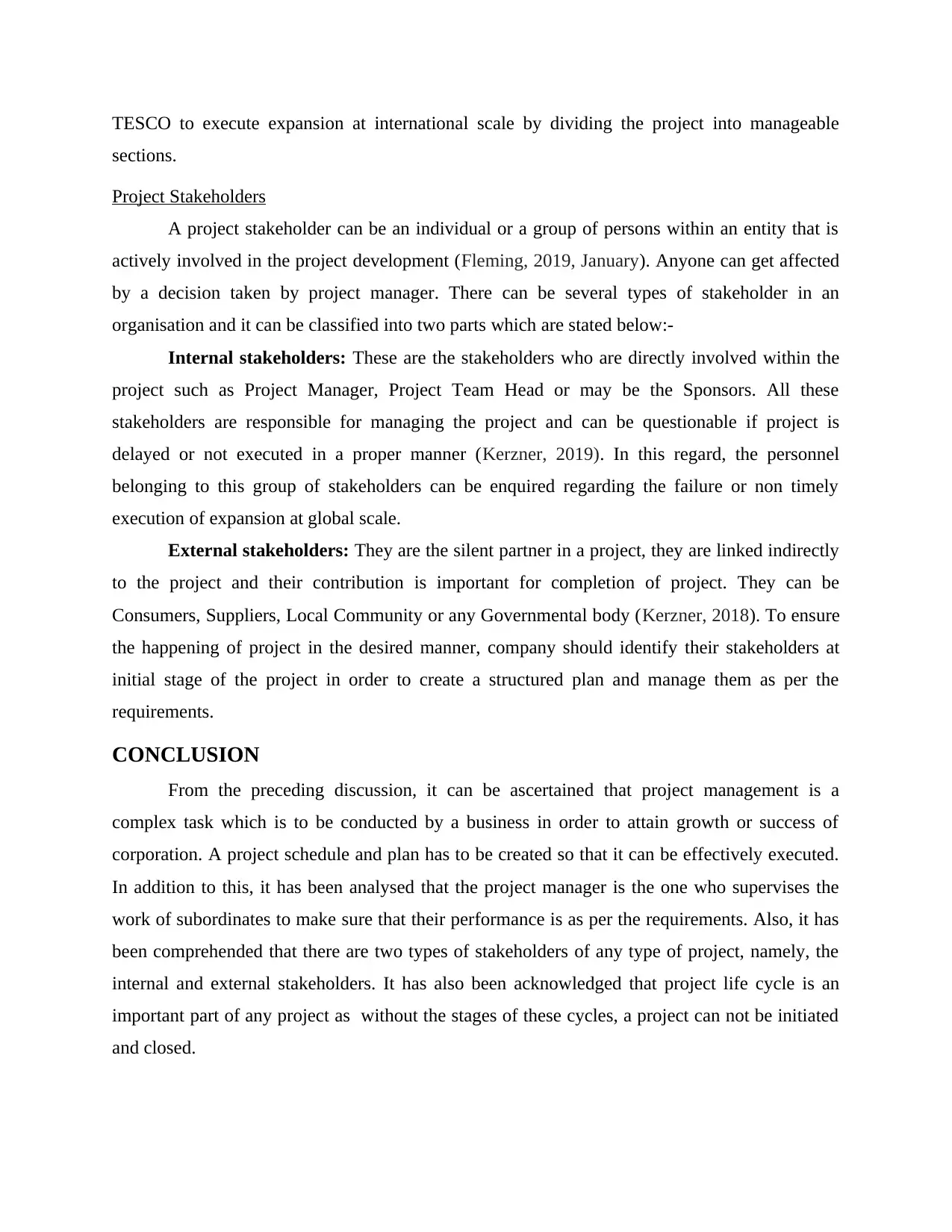
TESCO to execute expansion at international scale by dividing the project into manageable
sections.
Project Stakeholders
A project stakeholder can be an individual or a group of persons within an entity that is
actively involved in the project development (Fleming, 2019, January). Anyone can get affected
by a decision taken by project manager. There can be several types of stakeholder in an
organisation and it can be classified into two parts which are stated below:-
Internal stakeholders: These are the stakeholders who are directly involved within the
project such as Project Manager, Project Team Head or may be the Sponsors. All these
stakeholders are responsible for managing the project and can be questionable if project is
delayed or not executed in a proper manner (Kerzner, 2019). In this regard, the personnel
belonging to this group of stakeholders can be enquired regarding the failure or non timely
execution of expansion at global scale.
External stakeholders: They are the silent partner in a project, they are linked indirectly
to the project and their contribution is important for completion of project. They can be
Consumers, Suppliers, Local Community or any Governmental body (Kerzner, 2018). To ensure
the happening of project in the desired manner, company should identify their stakeholders at
initial stage of the project in order to create a structured plan and manage them as per the
requirements.
CONCLUSION
From the preceding discussion, it can be ascertained that project management is a
complex task which is to be conducted by a business in order to attain growth or success of
corporation. A project schedule and plan has to be created so that it can be effectively executed.
In addition to this, it has been analysed that the project manager is the one who supervises the
work of subordinates to make sure that their performance is as per the requirements. Also, it has
been comprehended that there are two types of stakeholders of any type of project, namely, the
internal and external stakeholders. It has also been acknowledged that project life cycle is an
important part of any project as without the stages of these cycles, a project can not be initiated
and closed.
sections.
Project Stakeholders
A project stakeholder can be an individual or a group of persons within an entity that is
actively involved in the project development (Fleming, 2019, January). Anyone can get affected
by a decision taken by project manager. There can be several types of stakeholder in an
organisation and it can be classified into two parts which are stated below:-
Internal stakeholders: These are the stakeholders who are directly involved within the
project such as Project Manager, Project Team Head or may be the Sponsors. All these
stakeholders are responsible for managing the project and can be questionable if project is
delayed or not executed in a proper manner (Kerzner, 2019). In this regard, the personnel
belonging to this group of stakeholders can be enquired regarding the failure or non timely
execution of expansion at global scale.
External stakeholders: They are the silent partner in a project, they are linked indirectly
to the project and their contribution is important for completion of project. They can be
Consumers, Suppliers, Local Community or any Governmental body (Kerzner, 2018). To ensure
the happening of project in the desired manner, company should identify their stakeholders at
initial stage of the project in order to create a structured plan and manage them as per the
requirements.
CONCLUSION
From the preceding discussion, it can be ascertained that project management is a
complex task which is to be conducted by a business in order to attain growth or success of
corporation. A project schedule and plan has to be created so that it can be effectively executed.
In addition to this, it has been analysed that the project manager is the one who supervises the
work of subordinates to make sure that their performance is as per the requirements. Also, it has
been comprehended that there are two types of stakeholders of any type of project, namely, the
internal and external stakeholders. It has also been acknowledged that project life cycle is an
important part of any project as without the stages of these cycles, a project can not be initiated
and closed.

REFERENCES
Books and Journals:
Kerzner, H. (2018). Project management best practices: Achieving global excellence. John
Wiley & Sons.
Kerzner, H. (2019). Using the project management maturity model: strategic planning for
project management. Wiley.
Huemann, M., Keegan, A., & Turner, R. (2018, September). Human resource management in the
project-oriented organization. Project Management Institute.
Fleming, Q. W. (2019, January). Project procurement management: contracting, subcontracting,
teaming. Project Management Institute.
Cha, J., Newman, M., & Winch, G. (2018). Revisiting the project management knowledge
framework: Rebalancing the framework to include transformation projects. International
Journal of Managing Projects in Business, 11(4), 1026-1043.
Premji, Z. (2018). The No-Nonsense Guide to Project Management. Journal of the Canadian
Health Libraries Association/Journal de l'Association des bibliothèques de la santé du
Canada, 39(2), 83-84.
Schwalbe, K. (2018). Information Technology Project Management, Loose-leaf Version.
Books and Journals:
Kerzner, H. (2018). Project management best practices: Achieving global excellence. John
Wiley & Sons.
Kerzner, H. (2019). Using the project management maturity model: strategic planning for
project management. Wiley.
Huemann, M., Keegan, A., & Turner, R. (2018, September). Human resource management in the
project-oriented organization. Project Management Institute.
Fleming, Q. W. (2019, January). Project procurement management: contracting, subcontracting,
teaming. Project Management Institute.
Cha, J., Newman, M., & Winch, G. (2018). Revisiting the project management knowledge
framework: Rebalancing the framework to include transformation projects. International
Journal of Managing Projects in Business, 11(4), 1026-1043.
Premji, Z. (2018). The No-Nonsense Guide to Project Management. Journal of the Canadian
Health Libraries Association/Journal de l'Association des bibliothèques de la santé du
Canada, 39(2), 83-84.
Schwalbe, K. (2018). Information Technology Project Management, Loose-leaf Version.
⊘ This is a preview!⊘
Do you want full access?
Subscribe today to unlock all pages.

Trusted by 1+ million students worldwide
1 out of 6
Related Documents
Your All-in-One AI-Powered Toolkit for Academic Success.
+13062052269
info@desklib.com
Available 24*7 on WhatsApp / Email
![[object Object]](/_next/static/media/star-bottom.7253800d.svg)
Unlock your academic potential
Copyright © 2020–2025 A2Z Services. All Rights Reserved. Developed and managed by ZUCOL.




